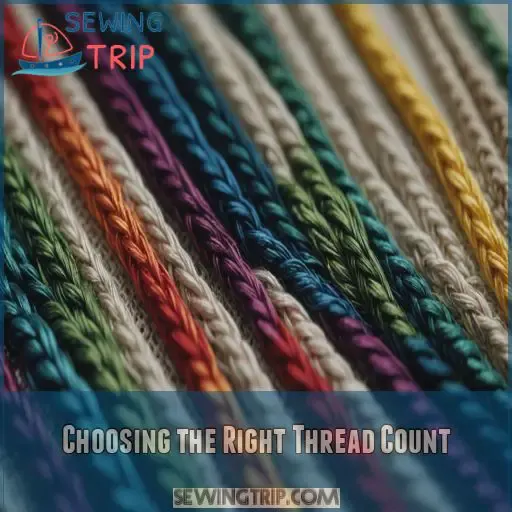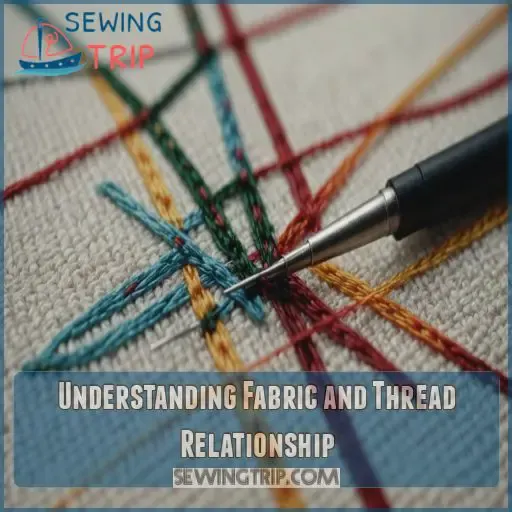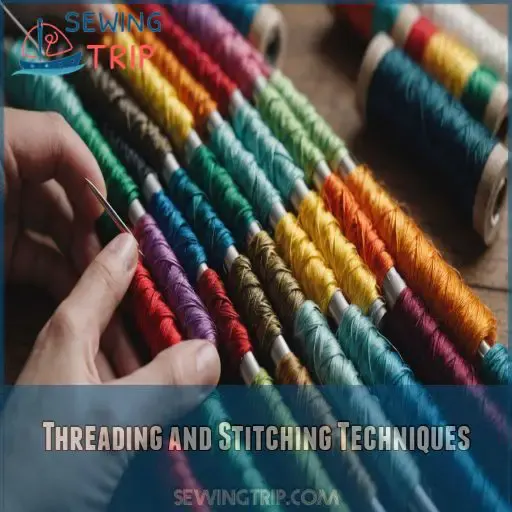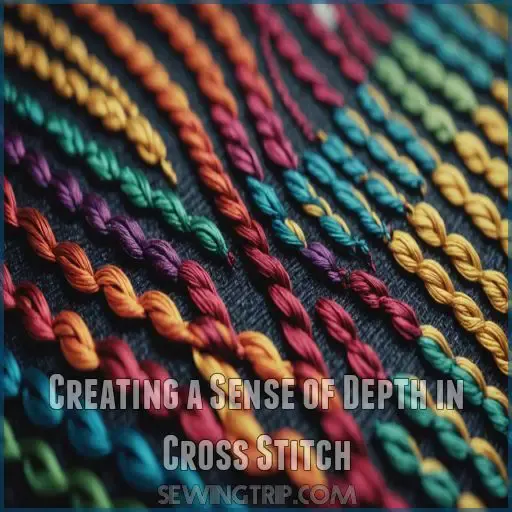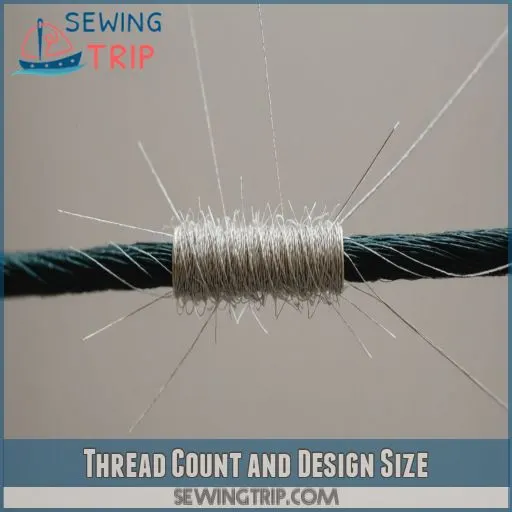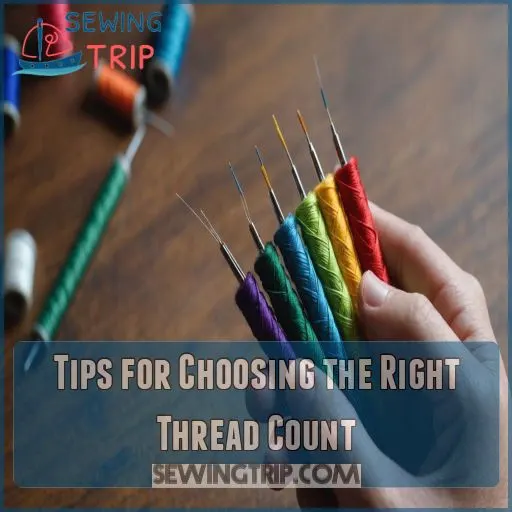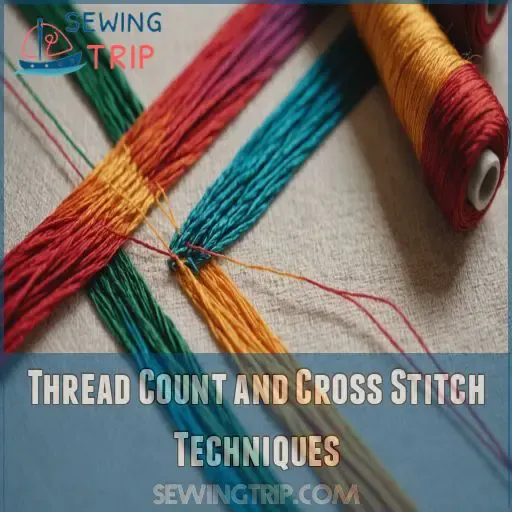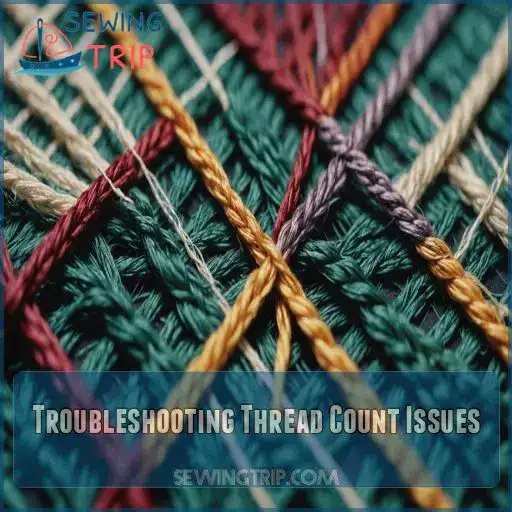This site is supported by our readers. We may earn a commission, at no cost to you, if you purchase through links.
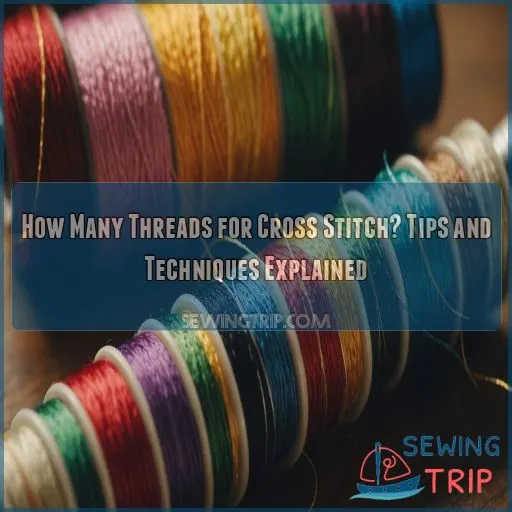
The standard go-to is two strands of floss for 14-count Aida, offering a harmonious balance between boldness and subtleness.
Fancy a dramatic art-nouveau flare? Add an extra strand for richer hues.
Or prefer a Monet-style impression? Go for a more ethereal look with just one strand.
Mix and match threads within a project to create texture and depth—like adding different instruments to your orchestra.
The key is experimentation, finding your own melody.
Stick around, and we’ll unravel more tips on crafting your masterpiece!
Table Of Contents
- Key Takeaways
- Choosing the Right Thread Count
- Understanding Fabric and Thread Relationship
- Threading and Stitching Techniques
- Creating a Sense of Depth in Cross Stitch
- Thread Count and Design Size
- Tips for Choosing the Right Thread Count
- Thread Count and Cross Stitch Techniques
- Troubleshooting Thread Count Issues
- Frequently Asked Questions (FAQs)
- Conclusion
Key Takeaways
- Experiment with thread counts like you’re mixing flavors in an ice cream sundae. Two strands on 14-count Aida is the usual go-to, but adding or removing strands can create amazing visual textures, just like changing toppings.
- Consider your fabric and personal flair. Whether you’re working with Aida or linen, your choice of strands can make a project as bold as a fireworks show or as subtle as a whisper in a library.
- Playing with thread counts isn’t just thread science – it’s stitch artistry. Use thick strands for pop-out elements and thin ones for background whispers, creating depth like a painter with brushes of various sizes.
- When determining your project size, it’s all about the numbers. Divide stitches by fabric count to find your design’s dimensions – add a margin like you add a cherry on top for the perfect framed finish.
Choosing the Right Thread Count
Choosing the right thread count in cross stitch is a bit like picking the perfect outfit; you want the look that suits you best and makes your project shine, and knowing the different counts available will help you find the perfect match.
Whether you’re following a pattern or adjusting for personal flair, understanding when to stick to the standard and when to mix things up will help bring your creative vision to life.
Standard Strand Count in Cross Stitch Patterns
Most cross stitch patterns provide a handy guide on the ideal number of strands to use when creating a cross stitch pattern.
However, don’t be afraid to experiment – the type of fabric, stitch style, and your personal preference can all influence the perfect strand count.
Embrace your creativity and find what works best for your unique project.
Personal Preference and Desired Look in Thread Count Selection
When you’re choosing thread count for cross stitch, think about the look you want.
A full-stitch look gives boldness, while a pencil-drawing style adds subtlety.
Mix and match thread counts for diverse effects, using thicker threads for density or opting for fine strands for delicate details.
It’s your artistic playground!
Understanding Fabric and Thread Relationship
In cross stitch, understanding the relationship between fabric and thread is like pairing socks—getting it right makes all the difference!
You’ll need to think about factors like the type of fabric, such as Aida or linen, and calculate your design size based on the fabric’s thread count to make sure your masterpiece comes together perfectly.
Thread Count and Fabric Type, Including Aida and Linen
So, you’ve chosen your thread.
The type of fabric, like Aida or linen, dances cheek to cheek with thread count, weaving magic in cross stitch.
Aida offers structure with its grid; linen whispers elegance and versatility.
Your choice between these two dictates your stitch density, blending filaments, and even those flashy metallic threads!
Calculating Design Size Based on Fabric Thread Count
Determining your project’s design size is a breeze! Simply divide the stitch count by your fabric’s thread count. For example, 140 stitches on 14-count Aida equals a 10-inch design.
Don’t forget to add a 3-5 inch margin for stretching, framing, or finishing – that’s the secret to professional-looking cross stitch!
Threading and Stitching Techniques
In cross stitch, threading your needle and choosing the right number of strands can make your project dazzle like a star on a clear night.
It’s like deciding between a single scoop of ice cream or the whole sundae—each choice shapes your stitching adventure!
Threading a Needle With Embroidery Floss
Having sorted fabric and thread, it’s time to thread your needle with embroidery floss.
Choose the right needle size for your floss type, and remember, knotless threading keeps floss tension smooth like butter on toast!
Determining the Right Number of Strands for a Project
When choosing thread count, consider the fabric type and your desired look.
Personal preference reigns supreme here, so experiment with different strands.
Finding your unique style can feel like discovering secret sauce in cross stitch!
Working With Different Thread Counts for Various Stitch Types
Experiment with different thread counts to see how they impact your stitches.
A lighter fabric may call for fewer strands, while a heavier one could benefit from more.
Play around to achieve your desired design effect.
Creating a Sense of Depth in Cross Stitch
In cross stitch, you can play with the number of strands to create depth and detail, almost like adding layers to a cake—just less delicious but equally satisfying!
Whether you want to bring certain parts of your design forward or give some areas a bit of background blur, adjusting your strand count does the trick.
Using Thick and Thin Lines to Create Depth
Creating depth in cross stitch is like drawing with threads! Use thick lines for areas you want to pop and thin lines for those fading into the background.
- Thicker strands for boldness
- Thin strands for subtlety
- Layer with purpose
- Highlight details
Varying Thread Count to Create a Sense of Distance
While thick lines pop, try thinning out strands to push elements back, creating depth and distance.
Just like in a painting, use these techniques to establish perspective and give your cross-stitch a magical illusion of layering.
Creating a Layered Effect With Different Thread Counts
To create a layered effect, use thicker strands for outlines to draw the eye, and thinner strands for smaller details, almost like a pencil sketch coming to life on the fabric.
Experiment until you find the perfect balance.
Thread Count and Design Size
When you’re figuring out the size of your cross-stitch design, thread count is like the GPS that guides your stitching journey.
cross-stitch insurance!
Calculating Design Size Based on Thread Count
Thread count is the magic number that determines your design size, like the sorting hat for your fabric.
Aida cloth or linen fabric, divide the number of stitches in your chart by the fabric’s thread count.
For instance, 140 stitches on 14-count fabric make a cozy 10-inch masterpiece.
Happy stitching!
Adding a Margin for Stretching, Framing, or Finishing
When you’re prepping your cross stitch masterpiece, adding some extra fabric around the edges can work wonders for stretching and framing. Try these tips:
- Margin Size: Add 3–5 inches.
- Framing Styles: Choose your frame in advance.
- Stretching Techniques: Get taut but not tight.
- Finishing Options: Consider mats or glass.
Tips for Choosing the Right Thread Count
When deciding on the right thread count for your cross stitch project, don’t be afraid to experiment!
After all, the perfect number of strands is ultimately a matter of personal preference and the look you’re going for.
Feel free to try out different options until you find the one that brings your design to life.
Experimenting With Different Thread Counts
Exploring thread count variations is a bit like being a cross-stitch maestro with an entire orchestra of color, stitch density, and fabric texture at your fingertips. Just imagine—each project gains a unique twist!
Thread count directly impacts the color variation and project impact of your cross-stitch endeavors.
| Thread Count | Color Variation | Project Impact |
|---|---|---|
| Low | Subtle | Delicate |
| Medium | Balanced | Versatile |
| High | Bold | Dramatic |
Considering Personal Preference and Desired Look
Your cross-stitch masterpiece is as unique as you are! When weighing thread count, your personal flair takes the spotlight. Consider these gems:
- Stitch Style: Experiment with different counts.
- Color Choice: Adjust strands for vibrancy.
- Project Size: More strands for larger pieces.
- Fabric Texture: Pair strands with weave tightness.
Thread Count and Cross Stitch Techniques
Choosing the right thread count is like finding the perfect pair of shoes—comfort and style go hand in hand.
You’ve got your pick of techniques to match your fabric.
Start by embracing the dance between thread count and stitch density for that elegant, even weave fabric look that’ll make your patterns pop.
Have fun with color blending to add pizzazz; think of it as mixing your favorite paint colors for that just-right hue.
Consider tension control as your guiding force: too tight, and your stitches might feel stifled; too loose, and they may lose their spark.
Find your sweet spot and create stitch magic!
Troubleshooting Thread Count Issues
Dealing with inconsistent thread counts or the wrong fabric type can be a real headache for cross stitchers.
But don’t worry – we’ve got your back with expert tips to solve those pesky thread count problems and get your project back on track.
Dealing With Inconsistent Thread Count
Thread count variations can throw a wrench in your stitching plans!
Maybe it’s brand differences or fabric tension causing inconsistency.
Focus on stitching consistency by checking each area before starting—like measuring twice before cutting fabric like measuring twice before cutting fabric.
Adjusting Thread Count for Different Fabric Types
When working with Aida, linen, or evenweave, adjust your thread count based on fabric type and stitch type.
Here’s how:
- Thicker threads for Aida
- Fewer strands on evenweave
- Linen needs experimentation
- Balance for desired look
Solving Common Thread Count Problems in Cross Stitch
Troubleshooting thread count issues can stitch you up!
If your work looks uneven, thread count inconsistencies might be your culprit.
Check the fabric type and stitch type effects, and remember, colorfastness snags shouldn’t knot your creative vision.
Frequently Asked Questions (FAQs)
How much thread do I need for cross stitch?
Worried you’ll mummify your cross stitch in thread?
It’s simple: start with 18 inches of floss and adjust strands by fabric type.
Most love 2-3 strands, but hey, stitch your story, not the rule book!
What does 2 threads mean in cross stitch?
In cross stitch, 2 threads mean you separate two strands from the six-stranded embroidery floss and use them together for stitching.
It balances coverage and detail, like spreading a comfy blanket over tiny squares.
How many threads to use on 20 count AIDA?
On 20 count AIDA, choose a path with 1 or 2 strands. Want a snug fit? Go for 2 strands for boldness. Prefer subtlety and more detail? 1 strand is your ticket. Stitch confidently!
How many strands of floss for 11 count aida?
For 11-count Aida, using three strands of floss will give your cross stitch a full, vibrant look.
Like Goldilocks finding the perfect porridge, three strands are just right—fuller than two but not overly chunky.
What is the history of cross stitch?
Cross stitch has a rich history dating back centuries, with origins tracing to ancient embroidery techniques.
From humble beginnings, it’s evolved into a beloved craft enjoyed by generations, allowing endless creative expression.
Discover the timeless allure of cross stitch!
Can cross stitch be done on clothing?
Imagine a vibrant pattern blossoming on your favorite denim jacket.
You can definitely stitch on clothing, which transforms and personalizes pieces with colorful flair.
Just make sure to secure your threads properly to withstand washes.
Are there cross stitch competitions or exhibitions?
Absolutely, you’ll find cross stitch competitions and exhibitions showcasing incredible artistry.
Competitors share their breathtaking projects, inspiring others.
It’s like a vibrant tapestry where creativity threads its way through, weaving a community of passionate stitchers.
How do I care for finished cross stitch pieces?
Don’t fret about post-stitch damage; just gently hand wash in lukewarm water with mild soap.
Rinse thoroughly, let it air dry flat, and avoid direct sunlight.
You’ll have a masterpiece that’ll stand the test of time!
What are the environmental impacts of cross stitching?
Embracing eco-friendly embroidery practices, like using organic threads and fabrics, can make a big difference in reducing the environmental impact of your cross-stitch projects.
By making sustainable choices, you’ll stitch a greener future one thread at a time.
Conclusion
Think of cross-stitching as orchestrating a masterpiece; just as each instrument contributes to a symphony, choosing the right thread count can transform your artwork.
Whether it’s deciding how many threads for cross stitch to achieve boldness or a whisper of color, your choice shapes the story.
Go on, be the maestro—experiment and let your creativity flow.
Embrace mistakes as serenades, and before you know it, you’ll create visual harmony in your stitched symphony.
Happy stitching!

